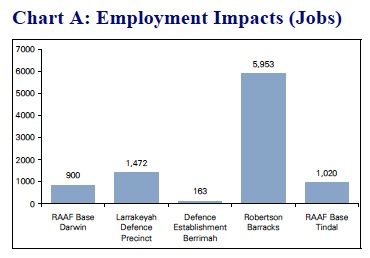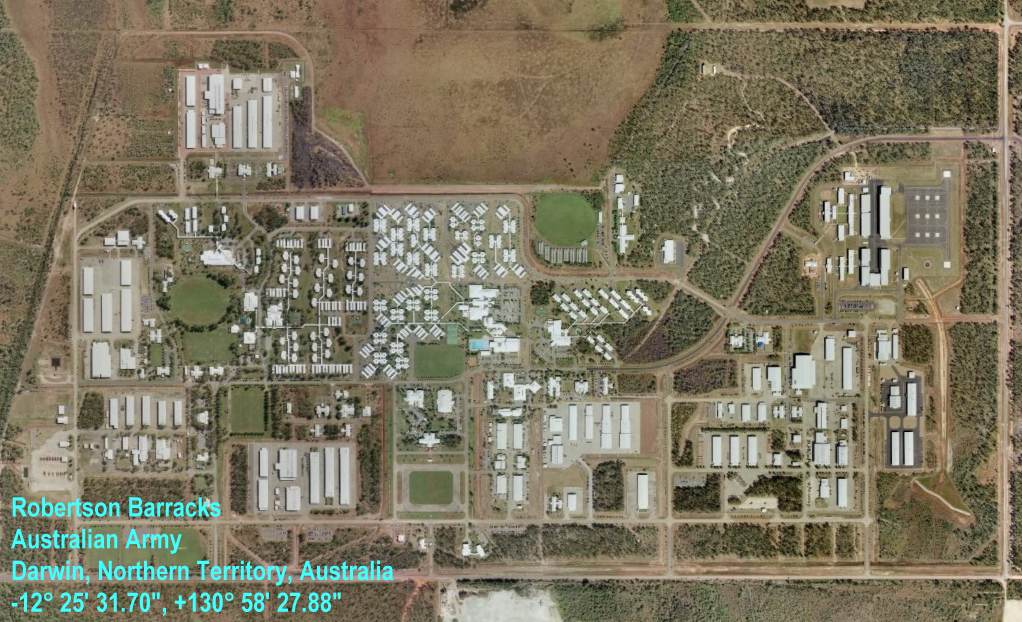Robertson Barracks
Introduction
Location: 12° 26′ 42″ S, 130° 58′ 28″ E
On 12 November 2011, US and Australian media reported that President Obama was expected to announce one or more new joint Australia-United States defence facilities. Australian sources predicted that US Marines would be stationed at Robertson Barracks in Darwin in the Northern Territory. Sources linked the predicted basing to US planning to counter Chinese regional influence. Robertson Barracks, located in the Darwin suburb of Holtze. Robertson Barracks is currently home to the Army 1st Brigade and elements of the 1st Aviation Regiment.
Government sources
Capability Fact Book, Australian Defence Force, 2003
Robertson Barracks is currently home to the Army 1st Brigade and elements of the 1st Aviation Regiment.
Economic Report into the Major Defence Bases in the Northern Territory, Final Report, KPMG Econtech, Department of Defence, 13 September 2010
Robertson Barracks is located 6km north of Palmerston on the Stuart Highway and covers approximately 964 hectares. Constructed in the early 1990s and named in memory of Lieutenant General Sir Horace Robertson, Robertson Barracks is a purpose-built facility that supports Army’s mechanised and army aviation operations and is the largest single military base in the Darwin region. Robertson Barracks is designated as a Forward Mounting Base for units accessing ranges and training areas in the region. Robertson Barracks also provides a significant number of living, working and training facilities and is the home of Australia’s 1st Brigade (1 BDE) which operates Australia’s mechanised force (including the M1A1 Abrams). The 1st Aviation Regiment, which operates the Tiger Armed Reconnaissance Helicopter (ARH), is co-located at Robertson Barracks in purpose-built facilities constructed in 2006.
Units and functions supported by Robertson Barracks include:
- 1st Brigade;
- 1st Aviation Regiment; and
- 1 Troop A Squadron Incident Response Regiment.
A $72 million redevelopment project commenced in 2009 to upgrade the existing facilities and infrastructure at Robertson Barracks. Improvements include new and upgraded training and working facilities, living-in accommodation, as well as new facilities and support services for 1 BDE.
The modelling estimates that Robertson Barracks directly and indirectly supports 5,953 jobs, in the Darwin region, a 9.7 per cent lift in employment than would otherwise be the case if the base did not operate in the region. This includes a 3.1 per cent gain in employment in the Government Administration and Defence industry, a 13.8 per cent gain in employment in the Finance and Insurance industry and a 0.2 per cent gain in employment in the Retail Trade industry. Robertson Barracks also directly and indirectly contributes $428 million (2008/09 prices) annually to value added, and contributes $382 million ($2008/09) annually to consumption in the Darwin regional economy. In percentage terms, the operations of Robertson Barracks leads to a lift of 6.6 per cent in value added and a 7.5 per cent lift in consumption in the Darwin region.

- Economic Report into the Major Defence Bases in the Northern Territory, Final Report, KPMG Econtech, Department of Defence, 13 September 2010
Social Impact of the Joint Force Posture Initiative on the Northern Territory: An issues paper for public consultation, Noetic Solutions Pty Limited, 18 May 2012
Parliamentary sources
Defence on stationing of US marines in Darwin, withdrawal of Afghanistan and other issues, Budget Estimates – Foreign Affairs, Defence and Trade Committee, Commonwealth of Australia, [Greens MPs, Australian Greens] (28 May 2012)
Analysis
Robertson Barracks, Wikipedia
“US Marine base for Darwin”, Peter Hartcher, Sydney Morning Herald, November 11, 2011
Barack Obama is to announce that the US will begin rotating Marines through an Australian base in Darwin in a permanent new military presence, intensifying the alliance in a sign of heightened concern about China. He is scheduled to make the announcement with the Prime Minister, Julia Gillard, when they visit Darwin next Thursday during Mr Obama’s first visit to Australia as president. The 26-hour visit will mark the 60th anniversary of the ANZUS alliance.
Two-thirds of all US Marines are based in the Pacific, with big concentrations at US bases on Okinawa Island in Japan and Guam, a US territory 2000 kilometres north of Papua New Guinea. Mr Obama and Ms Gillard are to say the US will not build a new base for the Marines but will use the Robertson Barracks, the Australian base near Darwin. But the base is home to about 4500 Australian soldiers and has capacity for only a couple of hundred more. The facilities will need to be expanded to accommodate the US Marines on rotation, whose numbers are expected to build. Such a decision has been under consideration for some years. The Marines are to use the base for training. ”They want to be able to fly helicopters, drop out of planes and shoot at things, and you can’t do that in crowded Okinawa,” in the words of Mike Green, a former top Asia adviser in the George W. Bush administration.
Permanent US presence for Darwin, Nigel Adam, Northern Territory News, 12 November 12th, 2011
There is likely to be a permanent US military presence in Darwin following an agreement between Washington and Canberra. Defence Minister Stephen Smith ruled out a permanent American base. “There are no United States bases in Australia and no proposal for such bases,” he said. But referring to the Pine Gap communications station near Alice Springs, he added: “We have joint facilities with the United States.”
The Americans want to establish a so-called pre-positioning base in Darwin – probably next to Robertson Barracks. The Federal Government said the base would hold equipment for humanitarian missions in Southeast Asia. But the base may also store military hardware. Reports said that US marines would be rotated through the base permanently.
Mr Smith used a Remembrance Day address in Perth to repeat that there will be a major increase in the American presence in the city to reflect the growing strategic and economic importance of the region. Mr Smith singled out an increase in visits by warships and greater involvement in the Pitch Black air exercise. Mr Smith also repeated that a “posture review” would lead to a greater Australian Defence Force presence in Darwin. He said Australian forces were positioned when the world “was quite different from today”. More Navy ships are expected to be based in Darwin, partly to protect oil and gas fields.
The Biggest Little Diplomatic Crisis You’ve Never Heard of, D.B.Grady, The Atlantic, 11 November 2011
Next week, President Barack Obama and Australian Prime Minister Julia Gillard are set to announce a new U.S. military presence at Robertson Barracks, an Australian base in Darwin. This will require a major expansion of the facility, and according to Mike Green, a former adviser to President George W. Bush, allow U.S. Marines “to be able to fly helicopters, drop out of planes and shoot at things.” Max Fisher has listed several reasons why this is a smart move for everyone involved, and the Obama administration deserves credit for anticipating distant threats in the region both obvious and abstruse. Australia is a stalwart ally of the United States, and has fought alongside U.S. troops in every major military campaign of modern times. Because of the UK-USA Agreement, the ANZUS Treaty, and fundamentally aligned goals in defense and foreign policy, setting up shop in Australia must have been as easy, diplomatically, as building a Walmart in Arkansas. The real question might be why it didn’t happen sooner, but that question is offset by the relief that it didn’t happen too late.
It’s a smart move for reasons beyond some hypothetical conflict with Beijing. An economically beneficial base and an American regional presence friendlier than the quiet and ongoing U.S. commando operations in the Philippines might well mend edges frayed by an exhausting decade of war. It might also bring neighboring New Zealand back into the full comity of ANZUS. Like a well-played game of Risk, this would solidify Western military interests in the Pacific.
5 Lessons of U.S. Plan for a Permanent Military Presence in Australia, Max Fisher, The Atlantic (online), 10 November 2011
Why is the U.S., at time of economic trouble and declining military deployments abroad, creating an all-new marine base in the land that Australians call Oz? Australia is a small-ish country by any measurement except for acreage, which is actually a poor way to understand the relative strength of nations. The World Bank ranks it 15th by GDP, between South Korea and the Netherlands. It’s ranked 52nd by population, less than one tenth the size of its northern neighbor, Indonesia. Its military spending is about on par with Spain. So this is probably not about protecting Australia itself. But repositioning U.S. forces in this way reveals how Obama sees the world — and America’s place in it — as changing. Here are five immediate lessons from the plan to build this new permanent base, something that suggests a significant change in long-term U.S. foreign policy.
- Yes, it’s about containing China’s military reach.
- U.S. focusing away from Middle East to East Asia.
- Obama wants out of Afghanistan.
- U.S. concerned about tension with Japan over military base.
- Could Australia be the new Saudi-style U.S. client? If the U.S. wants to build the kind of presence in East Asia that it could be closing out of the Middle East, it will need a reliable and pliant client state in the region. Japan is too powerful on its own and too independent; Indonesia might worry about a domestic backlash if it moves too close to the U.S.; South Korea is too worried about North Korea; and the nations of Southeast Asia are still not quite stable enough. But Australians are democratic, speak English, don’t have ideological reasons to oppose the U.S., and could really use a powerful sponsor, especially as China becomes more dominant. “Australia is like [the Persian] Gulf, cant possibly defend itself, relies on US protection. Politically can’t rock the boat, just like Gulf,” Australian journalist Tom Gara wrote on Twitter. This explains why Australia has joined every single American war, including Vietnam, which even the British wouldn’t touch.” Australia, like the nations of the Persian Gulf, might be willing to hand its foreign policy over to the U.S. in exchange for the implicit security guarantee of a large military base.
See also
Project coordinator: Richard Tanter
Updated: 12 November 2011


